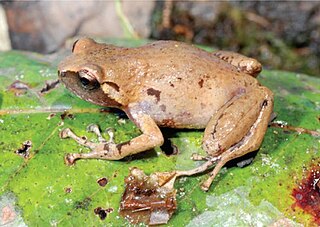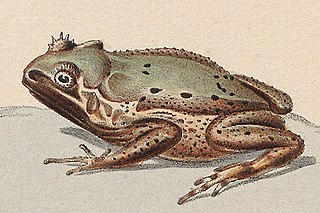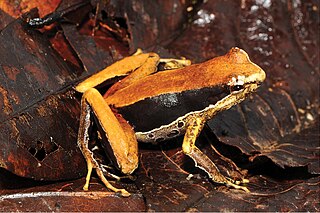
Choerophryne is a genus of microhylid frogs, commonly known as Torricelli mountain frogs, endemic to New Guinea. These frogs are small, with the body length measured from snout to vent between 11 and 23 mm.

Oreophryne, the cross frogs, is a genus of microhylid frogs endemic to Southern Philippine, Celebes and the Lesser Sunda Islands, and New Guinea.
Asterophrys leucopus is a species of frog in the family Microhylidae. It is endemic to northwestern Papua New Guinea where it is known from three locations: Stolle Mountain in the Sandaun Province—its type locality, and Hunstein Mountains in the East Sepik Province and the Bewani Mountains in the West Sepik Province.

Asterophrys turpicola is a species of frog in the family Microhylidae. It is widespread in New Guinea and found in both West Papua (Indonesia) and Papua New Guinea, although it appears to be absent from the eastern half of Papua New Guinea. It also occurs on the island of Yapen, off the north-western coast of New Guinea. The species is known for its aggressive behaviour: it can attack and bite viciously.
Cophixalus balbus is a species of frogs in the family Microhylidae. Molecular data suggest that it might belong to the genus Oreophryne. It is known from the vicinity of its type locality in Yapen island, Papua Province, Indonesia, as well as from the Hunstein Mountains and Bewani and Torricelli Mountains in Papua New Guinea.
Oreophryne atrigularis is a species of frog in the family Microhylidae. It is endemic to Western New Guinea (Indonesia) and known from its type locality, the Wondiwoi Mountains at the base of the Wandammen Peninsula, and from another location further east between Nabire and Mapia.
Oreophryne biroi is a species of frog in the family Microhylidae. It is endemic to New Guinea and occurs on the north coast from Madang Province in Papua New Guinea to the Cyclops Mountains in Papua province, Western New Guinea (Indonesia). The specific name biroi honours Lajos Bíró, a Hungarian zoologist and ethnographer who collected the holotype. Common name New Guinea cross frog has been coined for it.
Oreophryne brachypus is a species of frog in the family Microhylidae. It is endemic to the island of New Britain, in the Bismarck Archipelago of Papua New Guinea. Common name Gazelle cross frog has been coined for it.
Oreophryne clamata is a species of frog in the family Microhylidae. It is endemic to West Papua, Indonesia, and known from the Wondiwoi Mountains at the base of the Wandammen Peninsula, Papua province. The specific name clamata, meaning "makes a loud noise", refers to its striking advertisement call. Common name noisy cross frog has been proposed for this species.
Oreophryne geislerorum is a species of frog in the family Microhylidae. It is endemic to Papua New Guinea where it is known from the northern coast between the tip of the Huon Peninsula and south and east to Kokoda and Popondetta. The specific name geislerorum honours two German taxidermists, Bruno Geisler and his brother Herbert Geisler.
Oreophryne hypsiops is a species of frog in the family Microhylidae. It is endemic to northern Papua New Guinea and is known the Adelbert Range westward, including the adjacent coastal areas, to the Schrader Range and further to Lumi in the West Sepik Province. Prior to its description, it was mixed with Oreophryne biroi.
Oreophryne minuta is a species of frog in the family Microhylidae. It is endemic to Papua, Western New Guinea, and only known from its type locality in the Derewo River basin, in the mountains to the southeast of Cenderawasih Bay. It is a very small frog, and at the time of species description, the smallest Oreophryne species.

Aphantophryne nana is a species of frog in the family Microhylidae. It is endemic to the Philippines and is known with certainty only from the island of Camiguin. It is unclear whether similar frogs from northeast Mindanao are referable to this species. It was described as Oreophryne nana, but based on molecular data it was moved to Aphantophryne in 2017. Common names Camiguin cross frog, Camiguin narrow-mouthed frog, and volcano cross frog have been coined for the species.
Oreophryne notata is a species of frog in the family Microhylidae. It is endemic to Papua New Guinea and known from two localities, Ialibu, its type locality in the Southern Highlands Province, and Tabubil in the Western Province. It might occur more widely. The specific name notata is from Latin nota meaning a "mark" or "letter" and refers to the diagnostic U-like pattern on the lores.
Oreophryne sibilans is a species of frog in the family Microhylidae. It is endemic to West Papua, Indonesia. It is known from east of the main ridge of the Wondiwoi Mountains at the base of the Wandammen Peninsula, in the Papua province. Similar frogs have been collected from the Yapen island and the Fakfak Mountains, but it remains to be ascertained that these represent the same species. The specific name sibilans refers to the whistling advertisement call of the species.
Oreophryne unicolor is a species of frog in the family Microhylidae. It is endemic to West Papua, Indonesia, and known from the Wondiwoi Mountains at the base of the Wandammen Peninsula, Papua province. Frogs with similar call have been observed in the Fakfak Mountains, but it remains to be ascertained that these represent the same species. The specific name unicolor refers to the uniformly coloured dorsal side of the body.
Oreophryne wapoga is a species of frog in the family Microhylidae. It is endemic to Western New Guinea (Indonesia) and is known from its type locality, the headwaters of the Wapoga River, and from the island of Papua (province), both in the Papua province. The Yapen population might represent a separate species.
Djoko Tjahjono Iskandar is an Indonesian herpetologist who studies the amphibians of Southeast Asia and Australasia. He is a professor of biosystematics and ecology at Bandung Institute of Technology in West Java, Indonesia.
Nyctimystes purpureolatus is a species of frog in the subfamily Pelodryadinae. It is endemic to New Guinea and is known from its type locality on the Tiri River, a small tributary of the Mamberamo River in West Papua, Indonesia, and from three locations in West Sepik Province, Papua New Guinea.

Mantophryne insignis is a species of frog in the family Microhylidae. It is endemic to Woodlark Island in the Milne Bay Province of Papua New Guinea. The specific name insignis is Latin meaning "remarkable" or "conspicuous". It refers to the distinctive colour pattern of this frog, as well as to its unusual arboreal lifestyle within predominantly terrestrial genus.





